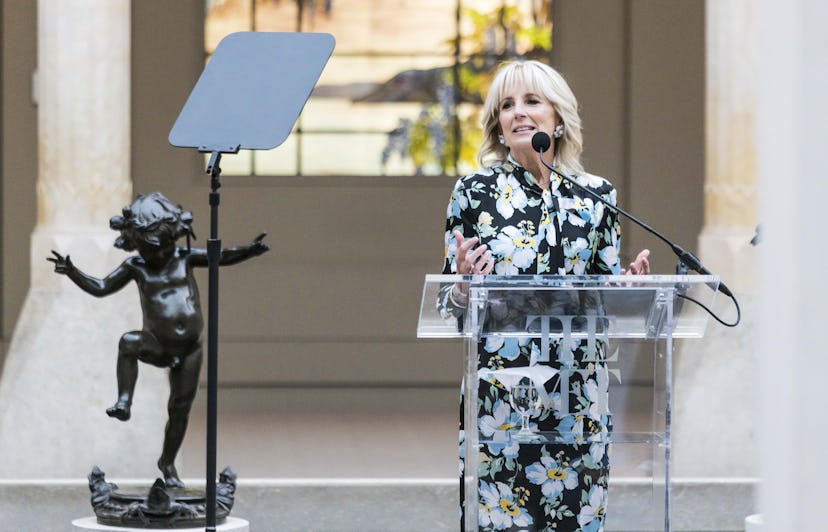Inside the Costume Institute’s “In America: An Anthology of Fashion” With Dr. Jill Biden
The First Lady decamped from the Capitol to open the Met Gala’s accompanying exhibition.

It would be another six hours before an A-lister set foot on the red carpet of the Metropolitan Museum of Art to attend the 2022 Met Gala, and yet dozens of onlookers were already camped out behind metal barriers across the street on Monday morning. (One had already grown tired enough to sit cross-legged on the street, never mind that it was wet with rain.) Most were likely hoping to eventually catch a glimpse of, say, Kim and Pete, but the more political-minded among them were in luck. The First Lady, Dr. Jill Biden, had just arrived to deliver opening remarks for the reason there’s actually a gala in the first place: the Costume Institute’s annual exhibition, this year titled “In America: An Anthology of Fashion.”
The presence of a White House official wasn’t the only thing different about this year’s preview. The institute enlisted nine of today’s top directors—including Martin Scorsese, Tom Ford, and Janicza Bravo—to activate what Head Curator Andrew Bolton admitted would otherwise be “rather static” displays by creating cinematic tableaux inside 13 of the museum’s American period rooms. Apart from enlivening the 100-plus garments on display, the placement also allows for the first of the two-part exhibition, “In America: An Anthology of Fashion,” to be on view concurrently at the Costume Institute through September 5.
Whereas the first exhibition was more of an overview of American fashion, the directors Bolton enlisted for the second honed in on specific examples of part two’s overarching themes: the emergence of an identifiable American style, and the rise of the name designer. Ma Rainey’s Black Bottom’s Regina King, for example, chose to shine a light on Fannie Criss Payne, a late 19th- and early 20th-century designer who was able to employ Black seamstresses like the realistic one the designer staged in a room soundtracked by two poems from Amanda Gorman’s collection Call Us What We Carry.
Inside Regina King’s Fannie Criss Payne-inspired vignette.
Bolton wasn’t kidding when he said the directors brought the displays to life. The mannequins were so realistic, it was easy to mistake them for real human beings. And apart from the footage that played on the walls of the rooms, there was more movement. Daughters of the Dust’s Julie Dash, for one, employed wind machines to send veils aflutter in her vignette, whose theme aimed to correct the oversight of Anne Loewe—an African American designer favored by high society women from the ’20s to the ’60s who never received credit for designing Jackie O’s wedding dress. (When asked who was behind it, the then First Lady replied, simply, a “colored woman.”)
Julie Dash’s room at the Costume Institute exhibition.
Inside The Benkard Room by Autumn de Wilde at “In America: An Anthology of Fashion.”
While Ford’s mannequins didn’t move, his were among the exhibition’s most dynamic. The director-slash-designer staged what he framed as a reinvention of the Battle of Versailles, the highly influential 1973 runway showcase of designers from the U.S. and France. The ensembles—which were all shown at the landmark event or in the designers’ runway shows of the same season—clothed mannequins that leaped and wielded swords against the backdrop of a panoramic John Vanderlyn painting of the opulent French castle.
Tom Ford’s depiction of the Battle of Versailles at the Metropolitan Museum of Art.
Another look at Ford’s Battle of Versailles-inspired room.
The Met Gala’s theme, “Gilded Glamour,” has prompted discussion of the fact that income inequality was at an extreme throughout the Gilded Age. (A spokesperson for New York City mayor Eric Adams, who is expected to attend, said that he “recognizes [the era]’s fraught history.”) Whether or not any of that will be acknowledged on the red carpet, politics are front and center at the start of the exhibition. It opens with three display cases: one containing a coat worn by George Washington, and two containing coats made by Brooks Brothers—one worn by President Abraham Lincoln when he was assassinated, and another worn by an enslaved person. (The American legacy brand has a little-known history of making uniforms for enslaved people, as the display case notes.)
Radha Blank’s display for Maria Hollander.
Back in the Charles Engelhard Courtyard just outside the exhibition, Dr. Biden was getting political, too. “As an English teacher, I’ve always believed in the power of language. And since I’ve become First Lady, I’ve been reminded that it’s only one way that we communicate,” she said. “A few months ago, as the President was preparing for the State of the Union address, my mind was a world away. Like so many Americans, I was transfixed by the news of Ukraine. The bombings. The parents weeping over children’s broken bodies in the streets. As the State of the Union approached, I knew the only thing that would be reported about me was about what I was wearing.”
So, Dr. Biden put in an order for some sunflower appliqués, repping the “symbol of hope and solidarity” that is the national flower of Ukraine. “I had one sewn on the cuff of my dress,” she continued. “It was small, but it shined against the deep cobalt blue of my sleeve. And that night, sitting next to the Ukrainian ambassador, I knew that I was sending a message without saying a word. That Ukraine was in our hearts and that we stood with them.” Don’t be surprised if one day, that very ensemble ends up on view at the Costume Institute.